Helina Gebremedhen
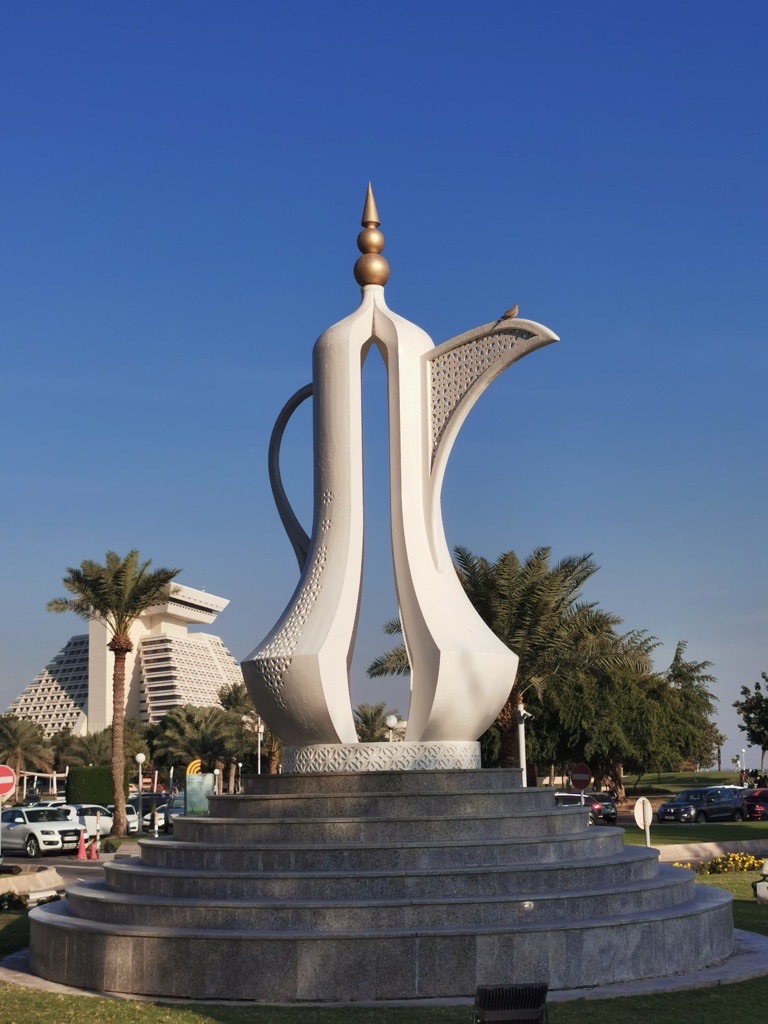
In the Qatari capital of Doha, a seven-kilometer waterfront promenade and roadway known as the Corniche provides spectacular views of the city’s curved skyline and serves as a preeminent public space. The entrance to al-Dafna park at its northernmost end is marked by a large sculpture of a coffeepot known as a dallah in Arabic (fig. 1). Standing several feet high on a stepped, circular pedestal, the monument is immediately recognizable as the everyday appliance, though its form is slightly abstracted and decorated with lattice panels.
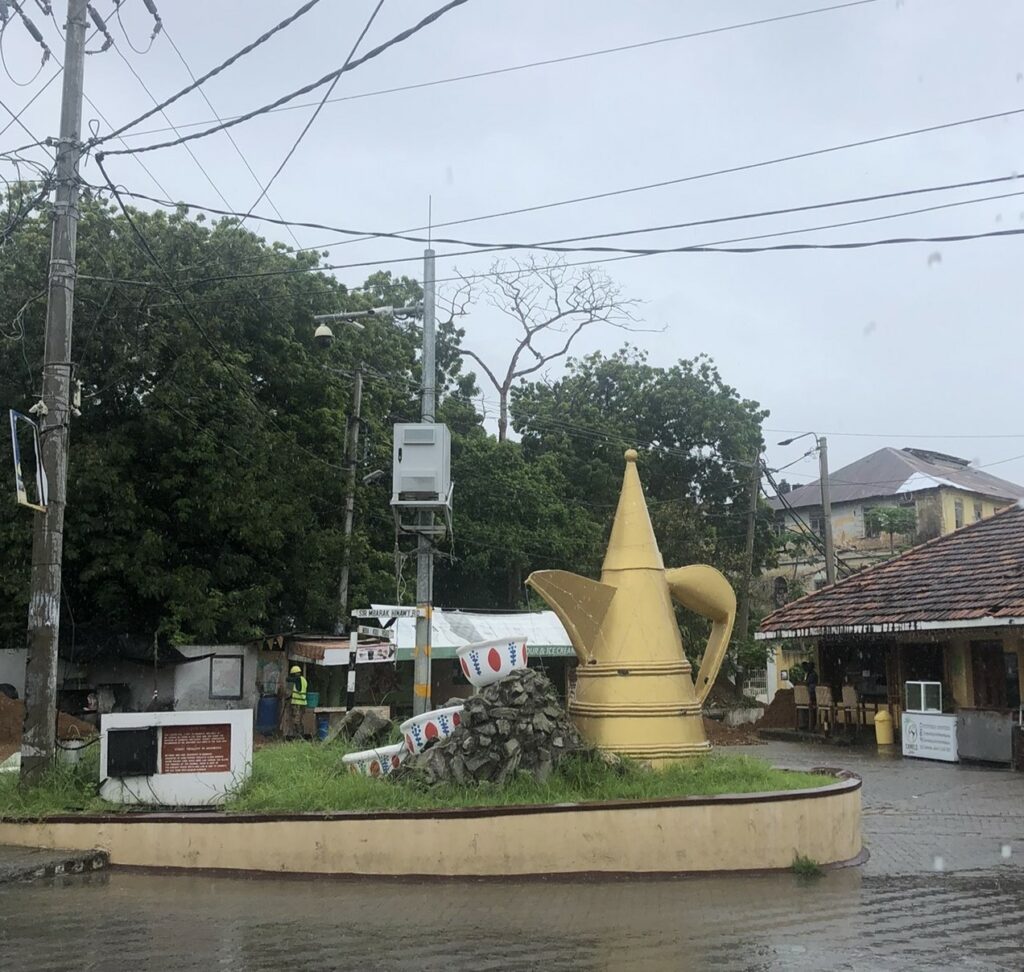
In the coastal city of Mombasa, Kenya, a roundabout in the city’s historic Old Town supports a three-foot, bronze-coloured kettle with a conical body and pointed lid, also called dalla in coastal Swahili (fig. 2). The accompanying cups, with their alternating red and green patterns recall popular ceramic sets encountered in homes across eastern Africa. Designed and installed in 1987-1988 by local artists Hussein Alawi and Ali Taher, this kettle references imported bronze pots valued for their capacity to keep coffee hot (Muraguri, 2015).1 Indeed, the cities and landscapes of the Indian Ocean region, including the adjacent Red Sea and the Gulf, are dotted with recurring nods to local domestic culture in the form of such monumental sculptures, where larger-than-life coffeepots, incense burners, and other domestic staples are integrated into the urban fabric. A similarly abstracted coffeepot sculpture graces a traffic roundabout leading into the historic village of St. Catherine, in Egypt’s Sinai Peninsula (fig. 3). In Ethiopia, a jebena (as it’s known in Amharic) is poised above a roundabout in the southwestern city of Jimma, its spout perennially pouring into a tray of the same patterned cups seen in Mombasa (fig. 4). A nearly identical installation anchors a roundabout in the Sudanese city of Port Sudan, on the Red Sea coast, and on the other side of the Arabian Peninsula, an ornate pot stands in the centre of a fountain and roundabout in Fujairah, United Arab Emirates, its bronze-coloured body embossed with designs of camels and stars (Fujairah Observer, 2022).
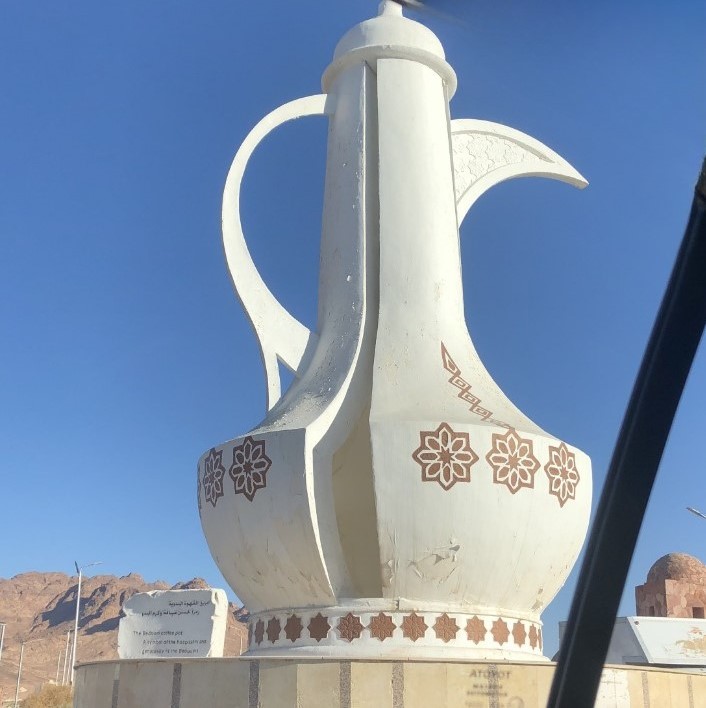
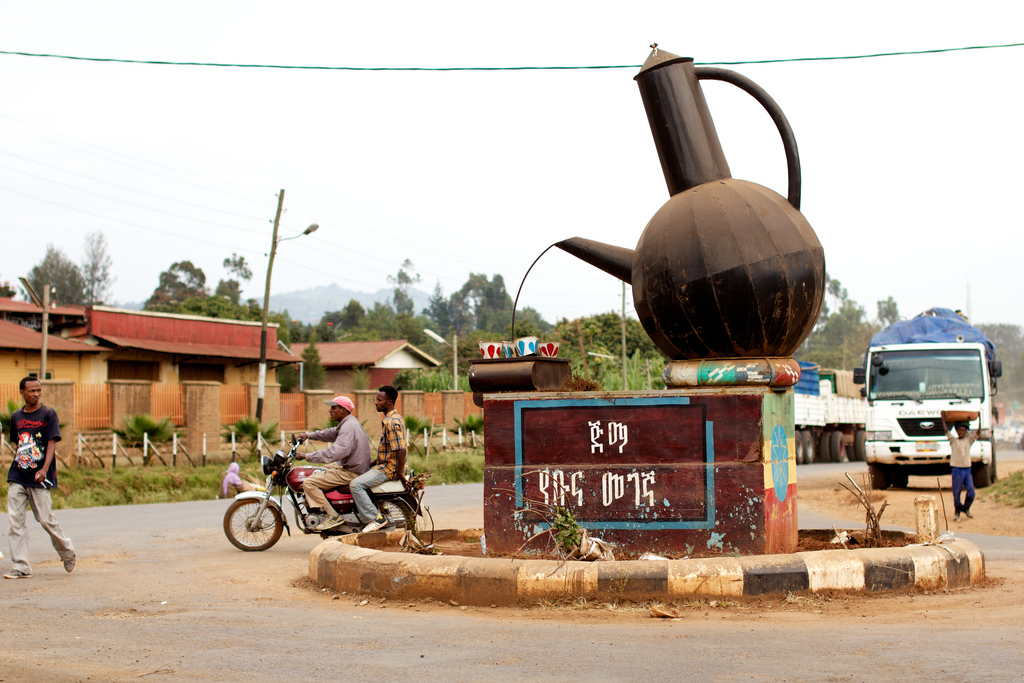
The erection of these sculptures, and dozens of other such monuments across several countries, suggests a wider regional resonance and prompted research into whether these monumental forms reflect a coordinated artistic phenomenon, and why quotidian coffee accessories have become a broad cultural symbol. The examples in Doha and Mombasa demonstrate that the monumental coffeepots are in fact hyper-local initiatives of the 1980s and 1990s, not products of any multilateral heritage project. The few scholarly mentions of Doha’s dallah emphasize it as part of an older generation of public sculpture tied to the city’s growth in the 1980s, constituting an “early phase of public art” that prioritized abstracted versions of Qatar’s heritage and history (Grichting et al. 2015, 587). The dallah thus stands in marked contrast to the contemporary boon in big-name international artist installations (Kelly 2016, 231; Suwaidi 2017, 112). Writing about the UAE in the 1970s, anthropologist Laila Prager notes how the Emirates’ newly-founded national museums “authenticated their particular national and territorial identities by assembling archaeological and ethnographic artifacts and selecting specific traditions and values believed to transcend time.” (Prager 2015, 23). The material culture of coffee – and by extension, its connotation of hospitality – features prominently in each of the seven Emirates’ national museums and “Living Village” experiences. Perhaps the monumental dallah in Fujairah, and many other examples across the UAE can be read as additional expressions of this process. In Oman, Amal Sachedina has argued that the transformation of the dallah from daily appliance to heritage symbol ca. 1970 is part of a bigger material and temporal distinction sought by the modern Omani state, which “co-opted particular material forms” to redefine the relationship to time, history, and the previous Imamate era (Sachedina 2019, 237). Local considerations also underpin Mombasa’s dalla, which was built under a different premise, at the behest of an employer who wanted a public commemoration of Kenya’s then President Moi. The artists countered with the coffeepot, a symbol that “had historical bearing with the local community,” (Muraguri 2015). Common to all examples is a clear desire for broad communal resonance. In contrast to the dhow, another popular Indian Ocean emblem, imagery from the domestic sphere offers a symbol that is already assimilated into popular culture and almost universally recognized. By reworking their scale from the handheld to the gigantic, and expanding their context from the kitchen to the urban thoroughfare, commissioners readily elevated the dallah from a functional everyday item into an abstracted symbol of shared public heritage.
Formalizing Heritage
In a way, these hyper-localized sculptures honouring everyday cultural practices have presaged a major shift in international heritage discourse. In 2003, UNESCO adopted the International Convention for the Safeguarding of the Intangible Cultural Heritage (ICH). Previous listings recognized singular artistic or architectural ‘masterpieces’ as examples of ‘universal’ heritage. In contrast, ICH seeks to mark “living heritage, primarily located in the skills, knowledge, and know-how” of specific communities, alongside their various “instruments, objects, artefacts, and cultural spaces,” (Blake 2015, 23). In 2015, the United Arab Emirates, Saudi Arabia, Oman, and Qatar submitted a joint application to UNESCO and secured the designation of “Arabic Coffee, A Symbol of Generosity” as one such living heritage along with a formal inscription to the agency’s Representative List of ICH (UNESCO 2015,6).2 Coffee-as-heritage, through both its social context of hospitality and its paraphernalia, has been formalized in other prominent ways within these signatory nations: in addition to the UAE’s display of coffee-culture in various national museums, the al-Fahidi historical district of Dubai is home to a dedicated coffee museum.
What are the implications, however, of codifying “intangible” heritage, especially through tangible icons? Do country-based designations imply a singular claim to practices that clearly transcend national borders, seen not least through the many coffeepot monuments independently erected across eastern Africa and the Arabian peninsula? For example, tensions arose in late 2022 when Singapore, Malaysia, Brunei, and Thailand submitted a joint bid to recognize the kebaya, a women’s garment worn across southeast Asia, as their ICH, though the bid did not initially include Indonesia, a neighbouring country that shared this practice and even named it as its national dress (Rashid 2022).3 The language established by UNESCO suggests a recognition of diverse practices claimed by many communities (Blake 2015, 27), but country-based designations, even with joint applications, raises the question of how a designation like ICH works within state-based safeguarding initiatives. For example, while the 2015 joint nomination for “Arabic coffee” acknowledges that similar practices are shared and well known in “countries that have strong ties with the Arabs, such as Somalia, Zanzibar in East Africa and especially Ethiopia (one of the main coffee exporters),” it shies from noting that the plant coffea arabica (and indeed the resulting beverage) is actually endemic to the latter. The award also describes the ways in which “Arabic coffee” practice will be preserved, noting that specifically Qatar and Oman will draw up “standard specifications… in a way that contributes to the protection of the element from negative influences.” (UNESCO2015, 12). The long-term impact of ICH designations for its beneficiary nations in the Gulf, for countries not part of the listing, and for the heritage practice in question remains to be observed.
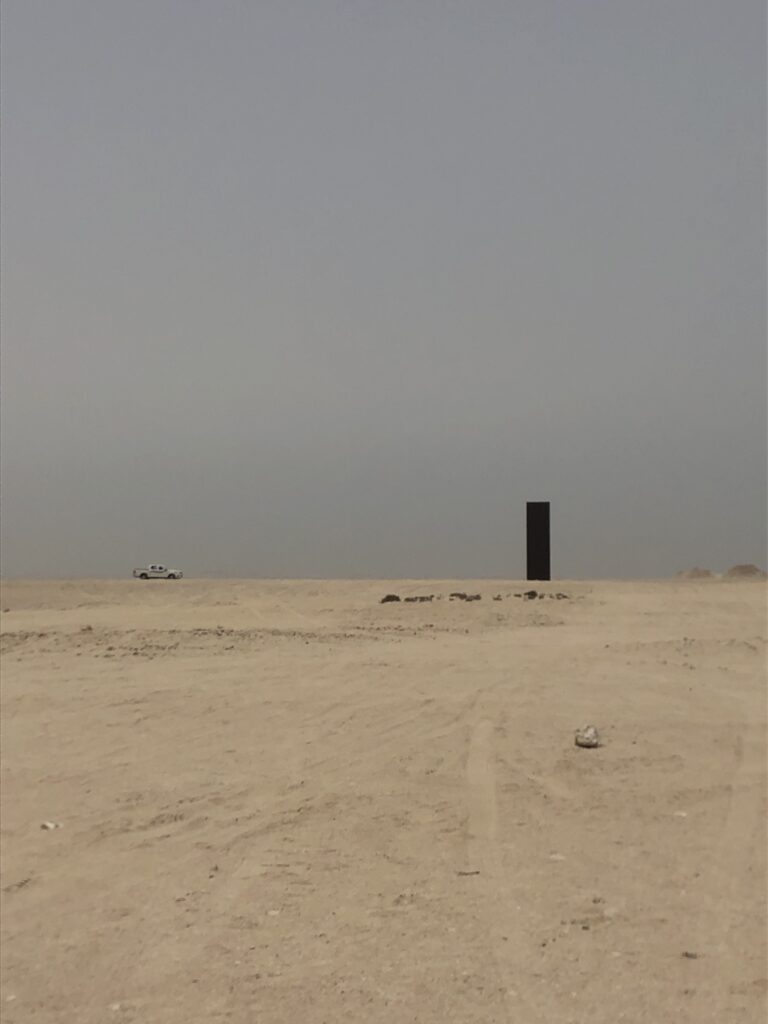
In addition to the cultural and social connotations evoked by the coffeepot sculptures, one can also consider them part of these cities’ broader heritage fabric. The dallah are not merely things in the landscape, though in their scale, modest materials, and relative anonymity they are easily overshadowed by newer art installations and striking architectural projects. One overseer of contemporary public art in Doha decried such older monuments’ limited functionality, comparing them to new and internationally legible commissions by well-known artists like Richard Serra’s East-West/West-East in Zikrit, Qatar (fig. 5) which “activate an area” (Suwaidi 2017, 118). The humble dallah should not be so quickly dismissed, however. These sculptures always occupy prominent public spaces and can serve as landmarks within the “mental maps” that all individuals draw upon to define and navigate their surroundings (Lynch 1960). Even the inconspicuous traffic roundabouts that frequently support the dallah order public space, and double as the hosts of these “artistic expression[s] of particular narratives of the city’s history,” (Rico 2014). Finally, the dallah also sometimes lends its name informally to the urban areas it anchors.
A new emblem?
In sum, the dallah, jebena, and others seem to represent heritage in two ways: first, in their evocation of hospitality as a tenet of local culture, and second, in their physical presence forming part of the urban environment. Individually endearing as markers of local culture, they are also striking when viewed collectively. Indeed, multiple societies and countries have tapped into the same motif in parallel to one another (at least, as far as this preliminary research can attest), turning an everyday object into a popular, legible, and vernacular symbol for a range of reasons. Together, the resulting monuments constitute a distinct (if inadvertent) western Indian Ocean heritage assemblage. These coffeepot monuments foster a kind of visual coherence, knitting together the urban landscapes of East Africa and the Arabian Peninsula. Local legibility is sometimes thus also regional legibility, and in an era of formalized heritage and growing global tourism, the dallah emerges as an organic and meaningful emblem for the western Indian Ocean.
Helina Gebremedhen is a PhD candidate in art history at the Institute of Fine Arts, New York University. Her research focuses on medieval African and Islamic art history, and the cultural, intellectual, and commercial connections and circulations between the Horn of Africa and the wider Red Sea and Indian Ocean regions. Areas of interest include talismanic practices, ajami manuscripts, historiography, and museum and heritage projects about these regions’ visual cultures. From 2022-2024, she was the Leigh and Mary Carter Director’s Research Fellow at the Cleveland Museum of Art, where she worked within the African art department to support the international loan exhibition Africa and Byzantium. She is also organizing the exhibition Arts of the Maghreb: North African Textiles and Jewelry set to open at the CMA in November 2024. She completed a MA in History, specializing in the Indian Ocean world, from McGill University and an Honours BA in Near and Middle Eastern Civilizations from the University of Toronto, Canada. Her languages include Amharic, French, and German; she is currently studying Arabic and Ge’ez.
Read the next essay: “Sacred Grave, Sacred Grove: Keramat Kusu Island as Sacred Forest”
by Faisal Husni >
- The monument was also refurbished in 2001 as documented by a plaque on the side of the ensemble. ↩︎
- In the nomination file, the applicants reference coffee-as-hospitality (the same value cited by the makers of the Doha and Mombasa examples), calling it a “ceremonial act of generosity” and noting that “the traditional coffee pot is a heritage symbol… found in decorative arts and handicrafts in the four States Parties.” Nomination File No. 01074 For Inscription on the Representative List of the Intangible Cultural Heritage of Humanity, (UNESCO, Convention for the Safeguarding of the Intangible Cultural Heritage, Tenth Session, Windhoek, Namibia, November 30-December 4, 2015). https://ich.unesco.org/en/RL/arabic-coffee-a-symbol-of-generosity-01074. ↩︎
- Amierul Rashid, “Kebaya Kerfuffle: Indonesians not pleased by Singapore and SEA countries nominating garment for UNESCO heritage list,” AsiaOne, December 15, 2022, https://www.asiaone.com/lifestyle/kebaya-kerfuffle-indonesians-not-pleased-singapore-and-other-sea-countries-nominating-unesco-heritage. ↩︎
Reference List
Blake, Janet. 2015. “From Global to Local Heritage: Intangible Cultural Heritage and the Role of the Museum.” Anthropology of the Middle East 10: 22-40.
Fujairah Observer. 2022. “Fujairah Roundabout Art: Dallah (Arabic Coffee Pot).” August 10, 2022. https://www.fujairahobserver.com/2022/08/10/fujairah-roundabout-art-dallah-arabic-coffe-pot/
Grichting, Anna, Sara al Sada, Angelica Caccam, and Urshi Khan. 2015. “Public Art and Public Space in an Emerging Knowledge Economy: The Case of Doha.” International Journal of Architectural and Environmental Engineering 9 (2): 582-588.
Kelly, Marjorie. 2016. “Richard Serra, Damien Hirst and Public Art in Qatar.” Public Art Dialogue 6 (2): 229-240.
Lynch, Kevin. 1960. The Image of the City. Cambridge: MIT Press.
Muraguri, Mwangi. 2015. “The big kettle of Fort Jesus and how it came into being.” The Sunday Standard, 2015. https://www.standardmedia.co.ke/article/2000167276/the-big-kettle-of-fort-jesus-and-how-it-came-to-being
Prager, Laila. 2015. “Displaying Origins: Heritage Museums, Cultural Festivals, and National Imageries in the UAE.” Horizons in Humanities and Social Sciences: An International Refereed Journal 1 (1): 22-46.
Rashid, Amierul. 2022. “Kebaya Kerfuffle: Indonesians not pleased by Singapore and SEA countries nominating garment for UNESCO heritage list.” AsiaOne, December 15, 2022. https://www.asiaone.com/lifestyle/kebaya-kerfuffle-indonesians-not-pleased-singapore-and-other-sea-countries-nominating-unesco-heritage
Rico, Trinidad. 2014. “Roundabouts abound no more: a eulogy,” in “Heritage and Renewal in Doha,” ed. C. Melhuish, B. Campkin, and R. Ross, special issue, Urban Pamphleteer 4 (November 2014). http://urbanpamphleteer.org/heritage-and-renewal-in-doha.
Sachedina, Amal. 2019. “The politics of the coffee pot: Its changing role in history-making and the place of religion in the Sultanate of Oman.” History and Anthropology 30 (3): 233-255.
Suwaidi, Maryam, and Raffaello Furlan. 2017. “The Role of Public Art and Culture in New Urban Environments: The Case of Katara Cultural Village in Qatar.” Architecture Research 7 (4): 109-122.Nomination File No. 01074 For Inscription on the Representative List of the Intangible Cultural Heritage of Humanity. UNESCO, Convention for the Safeguarding of the Intangible Cultural Heritage, Tenth Session, Windhoek, Namibia, November 30-December 4, 2015. https://ich.unesco.org/en/RL/arabic-coffee-a-symbol-of-generosity-01074.
